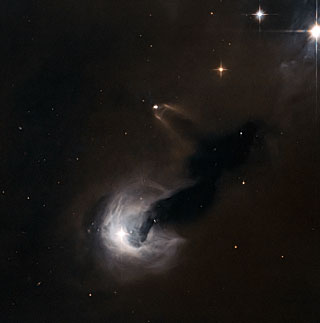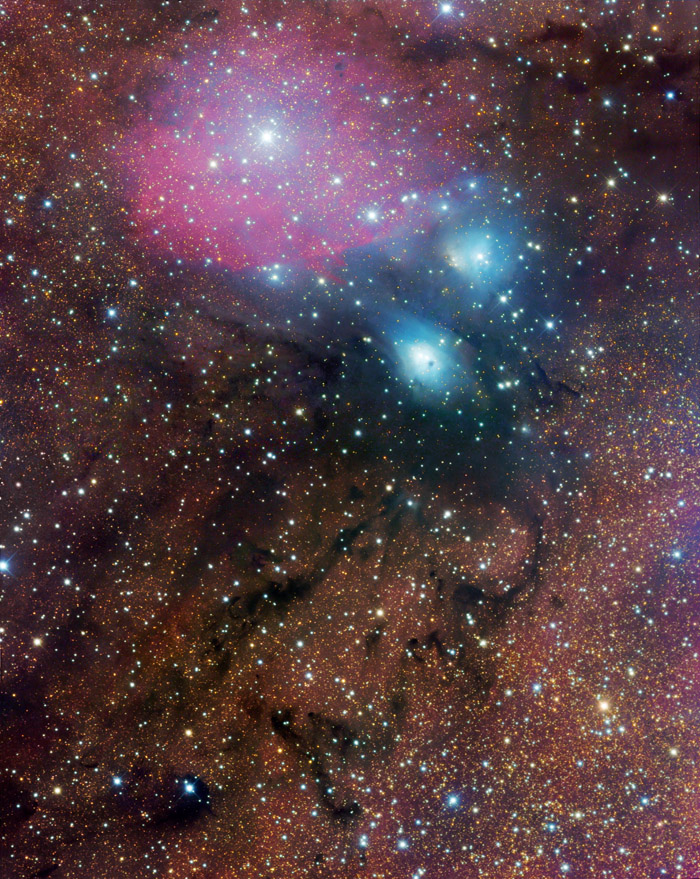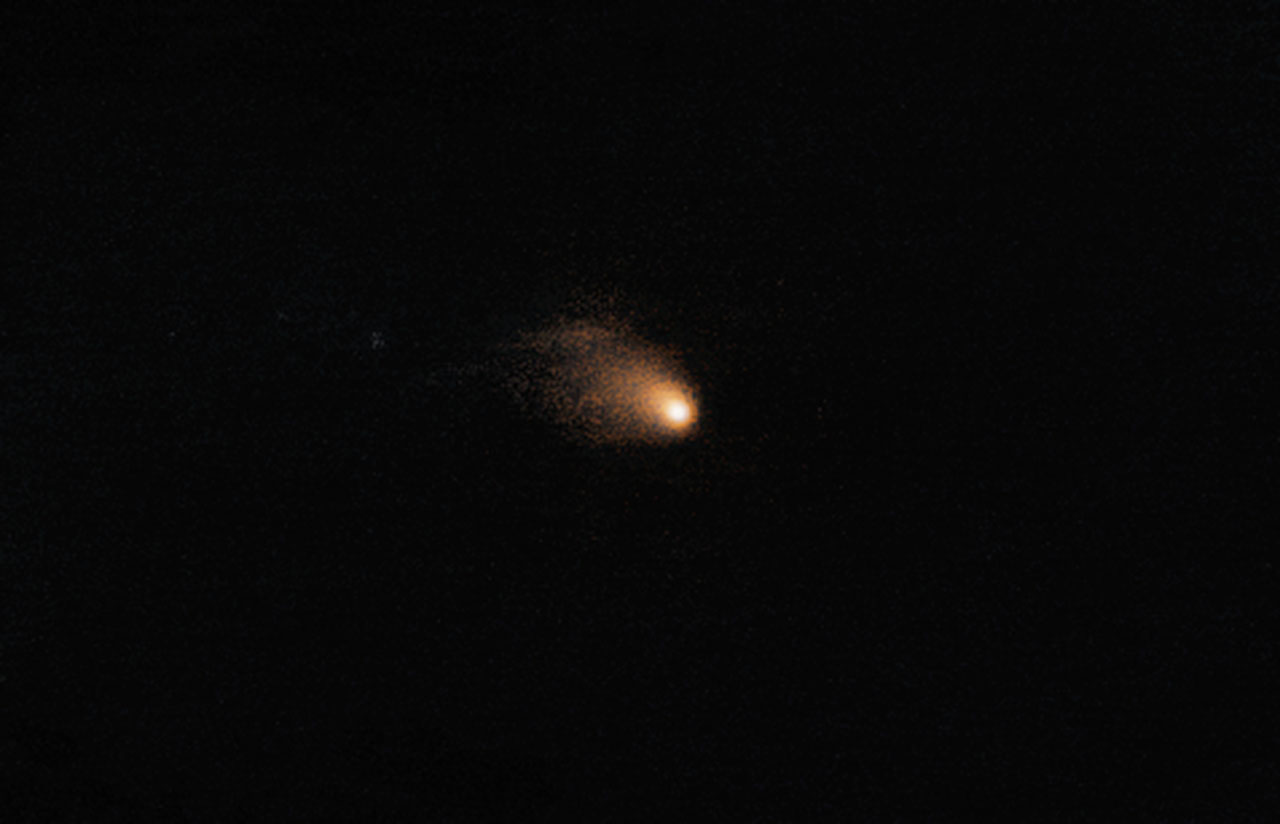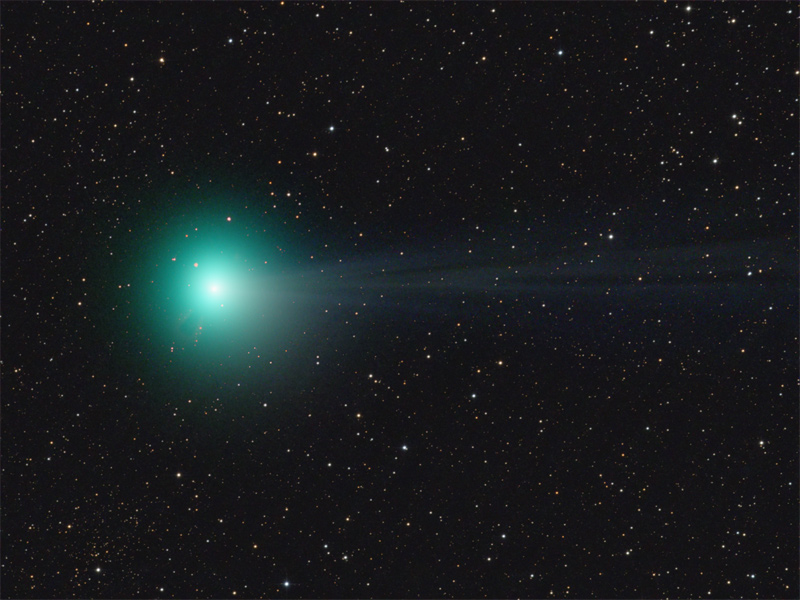Found images: 2014 September
Found images: 2014 September
Have you seen a great image or video somewhere that you think would make a great APOD? Nominate it for APOD! Please post as much information here as you have about the image/video with a link to any source(s) for it you know of here, and the editors will take a look.
When posting the image itself, please do not post anything larger than a thumbnail here; please honor the copyright holder's copyright.
Please keep hotlinked images under 400K.
Thank you!
<< Previous discoveries
-
starsurfer
- Stellar Cartographer
- Posts: 5330
- Joined: Thu Mar 15, 2012 7:25 pm
Re: Found images: 2014 September
47 Tucanae (NGC 104)
http://www.glitteringlights.com/Images/ ... JZPZbcF/X3
Copyright: Marco Lorenzi Some globular clusters belonging to the SMC are also visible in this widefield image. To the north is NGC 121 while the bright one to the south is Kron 3 and the smaller and fainter one to the left of it is Kron 7. The Kron catalogue is a catalogue of 69 star clusters in the SMC that was published in 1956 by Gerald Kron. 47 Tucanae is the second brightest globular cluster in the sky and is 13,000 light years away while the SMC is 210,000 light years away.
http://www.glitteringlights.com/Images/ ... JZPZbcF/X3
Copyright: Marco Lorenzi Some globular clusters belonging to the SMC are also visible in this widefield image. To the north is NGC 121 while the bright one to the south is Kron 3 and the smaller and fainter one to the left of it is Kron 7. The Kron catalogue is a catalogue of 69 star clusters in the SMC that was published in 1956 by Gerald Kron. 47 Tucanae is the second brightest globular cluster in the sky and is 13,000 light years away while the SMC is 210,000 light years away.
-
Efrain Morales
- Science Officer
- Posts: 492
- Joined: Fri Oct 22, 2010 8:15 pm
- AKA: Jaicoa
- Location: Aguadilla, Puerto Rico
- Contact:
Comet C/2014 Q1 PANSTARRS, September 1st
Comet C/2014 Q1 PANSTARRS, September 1st, 05:03ut. Passing in the region of nearby Galaxy PGC 751351 (top-right).
-
starsurfer
- Stellar Cartographer
- Posts: 5330
- Joined: Thu Mar 15, 2012 7:25 pm
Re: Found images: 2014 September
- geckzilla
- Ocular Digitator
- Posts: 9180
- Joined: Wed Sep 12, 2007 12:42 pm
- Location: Modesto, CA
- Contact:
Re: Found images: 2014 September
That's a pretty weird PN.
Just call me "geck" because "zilla" is like a last name.
-
starsurfer
- Stellar Cartographer
- Posts: 5330
- Joined: Thu Mar 15, 2012 7:25 pm
Re: Found images: 2014 September
It is quite strange but I've seen weirder! Not only does it look a little weird, it also has very little OIII. It was discovered in 1955 by Hugh Johnson and is also catalogued as RCW 181. It is interacting with the ISM and is also a highly evolved object with an age that is probably more than 10,000 years. I don't understand how it has hardly been studied since its discovery!geckzilla wrote:That's a pretty weird PN.
- MargaritaMc
- Look to the Evenstar
- Posts: 1836
- Joined: Wed Jan 09, 2013 10:14 pm
- Location: 28°16'7"N 16°36'20"W
Re: Found images: 2014 September
I was really taken aesthetically by the chiaroscuro of this image. It's interesting astronomically as well.Light and dark
http://www.spacetelescope.org/images/potw1434a/
This new NASA/ESA Hubble Space Telescope image shows a variety of intriguing cosmic phenomena.
Surrounded by bright stars, towards the upper middle of the frame we see a small young stellar object (YSO) known as SSTC2D J033038.2+303212. ... In this view from Hubble’s Advanced Camera for Surveys(ACS) it appears to have a murky chimney of material emanating outwards and downwards, framed by bright bursts of gas flowing from the star itself. ...
However, this small bright speck is dwarfed by its cosmic neighbour towards the bottom of the frame, a clump of bright, wispy gas swirling around as it appears to spew dark material out into space. The bright cloud is a reflection nebula known as [B77] 63, a cloud of interstellar gas that is reflecting light from the stars embedded within it. There are actually a number of bright stars within [B77] 63, most notably the emission-line star LkHA 326, and its very near neighbour LZK 18.
These stars are lighting up the surrounding gas and sculpting it into the wispy shape seen in this image. However, the most dramatic part of the image seems to be a dark stream of smoke piling outwards from [B77] 63 and its stars — a dark nebula called Dobashi 4173. ...
Margarita
"In those rare moments of total quiet with a dark sky, I again feel the awe that struck me as a child. The feeling is utterly overwhelming as my mind races out across the stars. I feel peaceful and serene."
— Dr Debra M. Elmegreen, Fellow of the AAAS
-
starsurfer
- Stellar Cartographer
- Posts: 5330
- Joined: Thu Mar 15, 2012 7:25 pm
Re: Found images: 2014 September
That is an amazing image! This area is part of the Perseus Molecular cloud and is near NGC 1333. Also the [B77] catalogue is usually referenced as Bernes but you have to type [B77] to access the Bernes catalogue in professional databases. One of the more well known Bernes nebulae is Bernes 157, which is part of the NGC 6726 complex in Corona Australis. Another photogenic one is Bernes 149, see this nice image by Fabian Neyer: http://www.starpointing.com/ccd/bernes149.htmlMargaritaMc wrote:I was really taken aesthetically by the chiaroscuro of this image. It's interesting astronomically as well.Light and dark
http://www.spacetelescope.org/images/potw1434a/
This new NASA/ESA Hubble Space Telescope image shows a variety of intriguing cosmic phenomena.
Surrounded by bright stars, towards the upper middle of the frame we see a small young stellar object (YSO) known as SSTC2D J033038.2+303212. ... In this view from Hubble’s Advanced Camera for Surveys(ACS) it appears to have a murky chimney of material emanating outwards and downwards, framed by bright bursts of gas flowing from the star itself. ...
However, this small bright speck is dwarfed by its cosmic neighbour towards the bottom of the frame, a clump of bright, wispy gas swirling around as it appears to spew dark material out into space. The bright cloud is a reflection nebula known as [B77] 63, a cloud of interstellar gas that is reflecting light from the stars embedded within it. There are actually a number of bright stars within [B77] 63, most notably the emission-line star LkHA 326, and its very near neighbour LZK 18.
These stars are lighting up the surrounding gas and sculpting it into the wispy shape seen in this image. However, the most dramatic part of the image seems to be a dark stream of smoke piling outwards from [B77] 63 and its stars — a dark nebula called Dobashi 4173. ...

Margarita
You can see Bernes 63 in this widefield image by Gimmi Ratto: http://www.collectingphotons.com/Astro/ ... /VdB16.htm
Also the description mentions that the dark nebula is Dobashi 4173 but the Dobashi catalogue is of infrared dark clouds. I don't know what filters were used for the Hubble image and don't know whether it is visible.
-
starsurfer
- Stellar Cartographer
- Posts: 5330
- Joined: Thu Mar 15, 2012 7:25 pm
- MargaritaMc
- Look to the Evenstar
- Posts: 1836
- Joined: Wed Jan 09, 2013 10:14 pm
- Location: 28°16'7"N 16°36'20"W
Re: Found images: 2014 September
I'd not heard of the Dobashi catalogue, but when I've just googled I found this record of a presentation by Kazuhito Dobashistarsurfer wrote: Also the description mentions that the dark nebula is Dobashi 4173 but the Dobashi catalogue is of infrared dark clouds. I don't know what filters were used for the Hubble image and don't know whether it is visible.
My assumption would be that optical data would show that there is obscuring dust of some kind and infrared observations can peer through the dust to get an idea what's within.http://www.ast.obs-mip.fr/article.php3?id_article=481
Atlas and Catalog of Dark Clouds Based on Digitized Sky Survey I
In this talk, I will introduce a quantitative atlas and catalog of dark clouds derived by using the optical database Digitized Sky Survey.
Thanks for the info about the square brackets used in the Bernes' catalogue! I had wondered about asking if anyone knew.In space, there are many regions which are hidden from optical telescopes because they are embedded in dense regions of gas and dust. However, infrared radiation, having wavelengths which are much longer than visible light, can pass through dusty regions of space without being scattered. This means that we can study objects hidden by gas and dust in the infrared, which we cannot see in visible light, such as the center of our galaxy and regions of newly forming stars.
http://coolcosmos.ipac.caltech.edu/cosm ... tance.html
Margarita
"In those rare moments of total quiet with a dark sky, I again feel the awe that struck me as a child. The feeling is utterly overwhelming as my mind races out across the stars. I feel peaceful and serene."
— Dr Debra M. Elmegreen, Fellow of the AAAS
-
starsurfer
- Stellar Cartographer
- Posts: 5330
- Joined: Thu Mar 15, 2012 7:25 pm
Re: Found images: 2014 September
Kazuhito Dobashi is the astronomer who published the Dobashi catalogue. However, the Atlas and Catalog of Dark Clouds Based on Digitized Sky Survey was never published and the Dobashi catalogue referenced on the Hubble page is based on infrared 2MASS images. There are some dark nebulae visible optically but there are some that are only visible in the infrared but not optically. Optical dark nebulae are usually made visible with something brighter behind them such as a nebula or the Milky Way. What about the dark nebulae hidden in more "dark" areas?MargaritaMc wrote:I'd not heard of the Dobashi catalogue, but when I've just googled I found this record of a presentation by Kazuhito Dobashistarsurfer wrote: Also the description mentions that the dark nebula is Dobashi 4173 but the Dobashi catalogue is of infrared dark clouds. I don't know what filters were used for the Hubble image and don't know whether it is visible.My assumption would be that optical data would show that there is obscuring dust of some kind and infrared observations can peer through the dust to get an idea what's within.http://www.ast.obs-mip.fr/article.php3?id_article=481
Atlas and Catalog of Dark Clouds Based on Digitized Sky Survey I
In this talk, I will introduce a quantitative atlas and catalog of dark clouds derived by using the optical database Digitized Sky Survey.Thanks for the info about the square brackets used in the Bernes' catalogue! I had wondered about asking if anyone knew.In space, there are many regions which are hidden from optical telescopes because they are embedded in dense regions of gas and dust. However, infrared radiation, having wavelengths which are much longer than visible light, can pass through dusty regions of space without being scattered. This means that we can study objects hidden by gas and dust in the infrared, which we cannot see in visible light, such as the center of our galaxy and regions of newly forming stars.
http://coolcosmos.ipac.caltech.edu/cosm ... tance.html
Margarita
-
starsurfer
- Stellar Cartographer
- Posts: 5330
- Joined: Thu Mar 15, 2012 7:25 pm
Re: Found images: 2014 September
NGC 6589-90
http://www.robgendlerastropics.com/NGC6589.html
Copyright: Robert Gendler NGC 6589 is the more northern of the two reflection nebulae with NGC 6590 below it. The large pink emission nebula is catalogued as IC 1283-4.
http://www.robgendlerastropics.com/NGC6589.html
Copyright: Robert Gendler NGC 6589 is the more northern of the two reflection nebulae with NGC 6590 below it. The large pink emission nebula is catalogued as IC 1283-4.
Re: Found images: 2014 September
This new NASA/ESA Hubble Space Telescope image shows a beautiful spiral galaxy known as PGC 54493, located in the constellation of Serpens (The Serpent). This galaxy is part of a galaxy cluster that has been studied by astronomers exploring an intriguing phenomenon known as weak gravitational lensing.
This effect, caused by the uneven distribution of matter (including dark matter) throughout the Universe, has been explored via surveys such as the Hubble Medium Deep Survey. Dark matter is one of the great mysteries in cosmology. It behaves very differently from ordinary matter as it does not emit or absorb light or other forms of electromagnetic energy — hence the term "dark".
Even though we cannot observe dark matter directly, we know it exists. One prominent piece of evidence for the existence of this mysterious matter is known as the "galaxy rotation problem". Galaxies rotate at such speeds and in such a way that ordinary matter alone — the stuff we see — would not be able to hold them together. The amount of mass that is "missing" visibly is dark matter, which is thought to make up some 27% of the total contents of the Universe, with dark energy and normal matter making up the rest. PGC 55493 has been studied in connection with an effect known as cosmic shearing. This is a weak gravitational lensing effect that creates tiny distortions in images of distant galaxies.
Know the quiet place within your heart and touch the rainbow of possibility; be
alive to the gentle breeze of communication, and please stop being such a jerk. — Garrison Keillor
alive to the gentle breeze of communication, and please stop being such a jerk. — Garrison Keillor
Re: Found images: 2014 September
Thank you for the fine processing of that picture, Geck! Thanks for giving me a chance to see that splendid galaxy.
Ann
Ann
Color Commentator
- geckzilla
- Ocular Digitator
- Posts: 9180
- Joined: Wed Sep 12, 2007 12:42 pm
- Location: Modesto, CA
- Contact:
Re: Found images: 2014 September
I didn't do the processing, there. The Hubble press release images are always processed by their people. My version looked like this and was one of the first things I ever processed. I didn't have a good sense of direction at that point. You can tell just from reading the description and comparing it to one of my newer images how far I've come in understanding things.
Just call me "geck" because "zilla" is like a last name.
-
starsurfer
- Stellar Cartographer
- Posts: 5330
- Joined: Thu Mar 15, 2012 7:25 pm
Re: Found images: 2014 September
RCW 58
http://wise.ssl.berkeley.edu/gallery_V385_Carinae.html
Copyright: NASA/JPL-Caltech/WISE Team RCW 58 is a Wolf Rayet nebula around the Wolf Rayet star WR 40 (also known as V385 Carinae). An optical image by Don Goldman can be seen here: http://www.astrodonimaging.com/gallery/ ... ?imgID=264
http://wise.ssl.berkeley.edu/gallery_V385_Carinae.html
Copyright: NASA/JPL-Caltech/WISE Team RCW 58 is a Wolf Rayet nebula around the Wolf Rayet star WR 40 (also known as V385 Carinae). An optical image by Don Goldman can be seen here: http://www.astrodonimaging.com/gallery/ ... ?imgID=264
-
starsurfer
- Stellar Cartographer
- Posts: 5330
- Joined: Thu Mar 15, 2012 7:25 pm
Re: Found images: 2014 September
NGC 2014 and NGC 2035
http://www.cosmicphotos.com/gallery/ima ... lbum_id=11
Copyright: Jason Jennings NGC 2014 is an open cluster associated with the filamentary emission nebula N57 near the left. NGC 2035 refers to the brightest part of the emission nebula near the right, the whole complex is also collectively known as N59. This also includes the supernova remnant DEM L241, which is the filamentary part near the right of it. Interestingly, N59 also includes a Wolf Rayet star but it doesn't have an associated Wolf Rayet bubble. However the turquoise bubble NGC 2020 to the right of NGC 2014 is the brightest example of a few Wolf Rayet nebulae found in the LMC. In fact the image includes a second Wolf Rayet nebula, the turquoise DEM L240 below N59. This region is at the edge of the supergiant shell LMC 4.
http://www.cosmicphotos.com/gallery/ima ... lbum_id=11
Copyright: Jason Jennings NGC 2014 is an open cluster associated with the filamentary emission nebula N57 near the left. NGC 2035 refers to the brightest part of the emission nebula near the right, the whole complex is also collectively known as N59. This also includes the supernova remnant DEM L241, which is the filamentary part near the right of it. Interestingly, N59 also includes a Wolf Rayet star but it doesn't have an associated Wolf Rayet bubble. However the turquoise bubble NGC 2020 to the right of NGC 2014 is the brightest example of a few Wolf Rayet nebulae found in the LMC. In fact the image includes a second Wolf Rayet nebula, the turquoise DEM L240 below N59. This region is at the edge of the supergiant shell LMC 4.
Re: Found images: 2014 September
The bright, hazy smudge at the centre of this image is a comet known as 67P/Churyumov-Gerasimenko, or 67P/C-G for short. This is not just any comet; it is the target for ESA’s Rosetta spacecraft, which is currently deep within the comet’s coma and less than 100 kilometres from its nucleus. With Rosetta so close to the comet, the only way to view the whole of 67P/C-G now is to observe it from the ground.
This image was taken on 11 August 2014 using one of the 8-metre telescopes of ESO’s Very Large Telescope (VLT) in Chile. It was composed by superimposing 40 individual exposures, each lasting 50 seconds, and removing background stars, to obtain the optimal view of the comet. Rosetta is contained within the central pixel of this image, and is too small to resolve. ...
Know the quiet place within your heart and touch the rainbow of possibility; be
alive to the gentle breeze of communication, and please stop being such a jerk. — Garrison Keillor
alive to the gentle breeze of communication, and please stop being such a jerk. — Garrison Keillor
Re: Found images: 2014 September
Far beyond the stars in the constellation of Leo (The Lion) is irregular galaxy IC 559.
IC 559 is not your everyday galaxy. With its irregular shape and bright blue spattering of stars, it is a fascinating galactic anomaly. It may look like sparse cloud, but it is in fact full of gas and dust which is spawning new stars.
Discovered in 1893, IC 559 lacks the symmetrical spiral appearance of some of its galactic peers and not does not conform to a regular shape. It is actually classified as a “type Sm” galaxy — an irregular galaxy with some evidence for a spiral structure. ...
Know the quiet place within your heart and touch the rainbow of possibility; be
alive to the gentle breeze of communication, and please stop being such a jerk. — Garrison Keillor
alive to the gentle breeze of communication, and please stop being such a jerk. — Garrison Keillor
-
starsurfer
- Stellar Cartographer
- Posts: 5330
- Joined: Thu Mar 15, 2012 7:25 pm
Re: Found images: 2014 September
-
starsurfer
- Stellar Cartographer
- Posts: 5330
- Joined: Thu Mar 15, 2012 7:25 pm
- geckzilla
- Ocular Digitator
- Posts: 9180
- Joined: Wed Sep 12, 2007 12:42 pm
- Location: Modesto, CA
- Contact:
Re: Found images: 2014 September
Vesta's Many Colors at Sextilia
Image credit: NASA/JPL-Caltech/UCLAMPS/DLR/IDA
http://dawn.jpl.nasa.gov/multimedia/Man ... xtilia.asp
Image credit: NASA/JPL-Caltech/UCLAMPS/DLR/IDA
http://dawn.jpl.nasa.gov/multimedia/Man ... xtilia.asp
Just call me "geck" because "zilla" is like a last name.
Re: Found images: 2014 September
ALMA Achieves New Short Wavelength Observing Capabilities
European Southern Observatory | ALMA | 2014 Sep 10
European Southern Observatory | ALMA | 2014 Sep 10
The Atacama Large Millimeter/submillimeter Array (ALMA) has reached a major milestone by extending its vision fully into the realm of the submillimetre, the wavelengths of cosmic light that hold intriguing information about the cold, dark, and distant Universe.
This achievement opens an entirely new window on the Universe for ALMA beyond its existing capabilities with the Band 9 receivers. It also is a critical step in the telescope's commissioning process, which brings its full capabilities to bear and makes them available to the international astronomical community.
As a demonstration of its new capabilities, the commissioning team released a new image of planet Uranus as it appears in submillimetre wavelength light. The image — obtained with ALMA's shortest wavelength, Band 10 receivers — reveals the icy glow from the planet's atmosphere, which can reach temperatures as low as -224 C (giving Uranus the coldest atmosphere in the Solar System). ALMA's now broader range of capabilities will enable astronomers and planetary scientists to study and monitor temperature changes at different altitudes above the clouds of Uranus and other giant planets in our Solar System. ...
Know the quiet place within your heart and touch the rainbow of possibility; be
alive to the gentle breeze of communication, and please stop being such a jerk. — Garrison Keillor
alive to the gentle breeze of communication, and please stop being such a jerk. — Garrison Keillor
- geckzilla
- Ocular Digitator
- Posts: 9180
- Joined: Wed Sep 12, 2007 12:42 pm
- Location: Modesto, CA
- Contact:
Re: Found images: 2014 September
Strange picture. I wonder what it looks like without the interpolation?
Just call me "geck" because "zilla" is like a last name.








